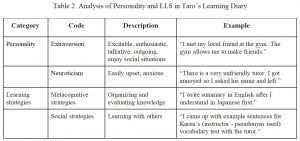Yukiko Oki, Hawaii Tokai International College
Oki, Y. (2019). An ethnographic approach to exploring personality, language learning strategies, and second language acquisition. Relay Journal, 2(1), 149-157. https://doi.org/10.37237/relay/020119
[Download paginated PDF version]
*This page reflects the original version of this document. Please see PDF for most recent and updated version.
Abstract
This paper is a case study examining the relationship between two individual difference (ID) factors, namely personality and language learning strategies (LLS), and language learning of two Japanese English-as-a-second-language (ESL) students. A qualitative analysis of their language learning histories, learner diaries, and interviews aims to uncover the role of personality in language learning and how personality seems to be reflected in their uses of LLS.
Keywords: individual differences, personality, language learning strategy, Japanese ESL learners
Literature Review
Personality is one of the ID factors associated with propensities (Ellis, 2004) researched to understand its influence on second language (L2) acquisition (Dörnyei & Ryan, 2015). Personality is referred to as the consistent patterns of how one feels, thinks, and behaves (Pervin & John, 2001). One of the most ubiquitous representations of the fundamental features of personality is the “Big Five” model (Pervin & Cervone, 2010) which identifies five main dimensions of human personality: openness, conscientiousness, extraversion, agreeableness, and neuroticism (Dörnyei & Ryan, 2015). Although there is a tendency to assume that a specific personality trait (e.g., extraversion or introversion) significantly determines one’s success in language learning, research has rather been equivocal and inconclusive (Dörnyei & Ryan, 2015).
LLS, an ID factor categorized as learner actions (Ellis, 2004), is defined by Oxford (as cited in Ellis, 2004) as “behaviors or actions which learners use to make language learning more successful, self-directed, and enjoyable” (p. 544). When learning a language, learners deliberately and consciously use strategies that reflect their preferences in learning. Adjusting the LLS frameworks proposed by Oxford (1990) and O’Malley and Chamot (1990), the representative typologies consist of four components: cognitive strategies, metacognitive strategies, social strategies, and affective strategies (Dörnyei & Ryan, 2015, p.149). Successful language learners have reported a wider range and more sophisticated use of learning strategies than unsuccessful learners (Gan, Humphreys, & Hamp-Lyons, 2004).
Since learning strategies are most notably linked to motivation and learner beliefs (Dörnyei & Ryan, 2015), studies that investigate the relationship between personality and learning strategies seem to be scarce. Nevertheless, significant correlations between personality traits and LSS seem to be evident (Kang, 2012; Liyanage & Bartlett, 2013). Openness and conscientiousness, in particular, have been found to be the strongest predictors of language learning strategy use (Kang, 2012) while neuroticism is often negatively correlated with metacognitive strategies (Ayhan & Türkyılmaz, 2015; Kang, 2012). Liyanage and Bartlett (2013) found that while personality types and LLS preferences are related, this association is quite volatile. In other words, either an extroverted or an introverted learner will have an advantage depending on specific LLS or tasks. Furthermore, either personality will be at a greater advantage when combined with low neuroticism. Learners’ LLS preferences are affected by their internal states and the external factors and strategic action, like chameleons changing colors.
Research questions
In light of these discussions in the literature about personality, LLS, and their effect on language learning, this case study aims to answer the following questions:
- Does personality appear to play a role in language success in two ESL learners?
- How do the personalities of two ESL learners appear to be reflected in their strategies for language learning?
Methods
Participants and context
The participants of the study were chosen from an advanced grammar course taught by the researcher in the College Preparatory (CP) program, an English-as-a-second-language (ESL) program, at Hawaii Tokai International College (HTIC) in Kapolei, Hawaii. First, all of the nine (i.e., Japanese ESL) students were informed about the purpose and process of the project. All the students agreed to complete a short survey about their academic background in the CP program: their date of entry to the program, the levels they have repeated or skipped, highest TOEFL score, and current GPA. Finally, two male students, Ryotaro and Taro (pseudonyms are used) were then selected through purposeful sampling (Griffee, 2012) as their backgrounds were deemed to be the most helpful in informing the researcher about the constructs.
Ryotaro was placed into level two upon entry to the CP program in spring 2018. His high TOEFL ITP score, GPA, and a unanimous recommendation from his instructors enabled him to skip from level three to level five. He continues to perform well in his courses this term obtaining an A in all his courses with a cumulative GPA of 3.78. His fast progress and high achievement in the CP program classify Ryotaro as the “successful English language learner” in this study.
Taro entered the CP program in spring 2017. He has never skipped a level but has repeated level two and level three once each. Neither his highest TOEFL ITP score nor his current GPA meets the requirement to complete the CP program. Thus, his slower progress in the program and being on the verge of repeating level five are the rationales for identifying Taro the “less successful language learner” in this paper.
Data collection
This case study will adopt an ethnographic approach to answer the aforementioned research questions. This approach aims to gain a holistic view of the learners by collecting multiple sources of data to strengthen the interpretation of data (Dörnyei, 2007; Griffee, 2012). The data collected in this study were language learning histories, learner diaries, and semi-structured interviews.
Language learning histories. Over one weekend, each participant was asked to write his language learning history in English. Language learning histories are personal narratives that “provide insight into the meaningful aspects of learning from the perspective of the student themselves” (p. 20) and are thought to be applicable when obtaining data regarding psychological differences including learning strategies and identity (Murphey & Carpenter, 2008). The prompt was adopted from Murphey and Carpenter (2008) and no requirement was set for the number of words.
Learner diaries. Each participant was asked to keep an English learning diary for a week in English and/or Japanese on a Google document from October 25th to November 1st reflecting on his language learning feelings, preferences, and experiences in and outside of class. Learner diaries allow the researcher to tap into the learner’s psychological, physiological processes they go through on a daily basis in an unobstructed way (Dörnyei, 2007). The guidelines for the diary entries were adopted from Gan, Humphreys, and Hamp-Lyons (2004), and there was no required length for each entry.
Interview. Individual follow-up semi-structured interviews were conducted in English and Japanese. Semi-structured interviews allow the researcher to set the direction of the interview while allowing the interviewee to elaborate on certain issues (Dörnyei, 2007), in this case, those pertaining to personality and language learning strategies. The interviews lasted about thirty minutes and were voice-recorded with the consent of the participants. The interviews took place in the researcher’s office after school.
Data analysis
The data collected for this study, which are language learning histories, learner diaries, and recorded interviews, were analyzed qualitatively. Any Japanese used in the learner diary (only in Taro’s diary) was translated into English. Due to time constraints, tape-analysis (i.e., taking notes while listening to the recording) was carried out to transform the interview recordings into a textual form (Dörnyei, 2007).
Initial coding of the data involved descriptive coding in which a descriptive code was assigned to each unit of data to summarize the primary topic of the excerpt (Saldaña, 2013). Particular attention was given to factors that revealed aspects of their personality traits and their language learning strategies. In the second-level coding (Dörnyei, 2007), similar or related codes were grouped under a broader category (Saldaña, 2013). The categories represented the Big Five personality types and the four types of language learning strategies.
Results
Tables 1 and 2 display personality types and learning strategy types that were prominent in each participant’s data. The word clouds (Figures 1 and 2) provide frequently used words at a glance.
Ryotaro perceived his personality to be extraverted, which was also evident from the analyzed data. He especially enjoys having casual conversations in English with locals on weekends and seeks opportunities to do so. He thinks that being outgoing is an important personality trait to be a successful language learner and speaking with locals is the best way to improve English. Not surprisingly, “speak” was one of the most frequently used words in the data. In addition, Ryotaro also showed consistent signs of conscientiousness where he would set a goal (e.g., doing well on tests, scoring high on TOEFL ITP) and make plans to achieve it. This might be related to the fact that the majority of his L2 studying consisted of metacognitive strategies. He realizes his L2 errors or shortcomings on his own, thinks about how he can improve them, and executes his plan. His desire to improve and become better at English is represented in the word “want,” another one of his most frequently used words.
Taro also thinks of himself as an extrovert and has local friends who he met at the gym. He also enjoys group (L2 speaking) activities in class with his (Japanese) classmates. He occasionally shared experiences that reflected features of neuroticism, especially when he got upset at an unfriendly tutor or felt frustrated towards the differences between English and Japanese grammar. Taro thinks that one’s purpose, instead of personality, is a determinant of one’s success in language learning although he does not have a clear purpose for learning English.
Taro showed some signs of strategy use; however, as seen in the word cloud, he mentioned occasionally that he “thinks” a particular activity or method of studying is helpful for improving his English skills. This gave the impression that he was rather uncertain about the effectiveness of his strategies. This might explain his strong preference for social strategies. Because he is aware of his limited abilities and lack of knowledge on strategies, he prefers to study with his classmates from his cohort who would point out his error and who he can easily ask questions to in Japanese. However, since the students in his cohort have advanced or completed the program, he feels like he has “lost” his friends to study with, and this situation has inevitably led him to visit the tutors, as reported in the diary.



Figure 1. Word Cloud from Ryotaro’s Data

Figure 2. Word Cloud from Taro’s Data
Discussion
Some relationship between personality and success was evident from the data. Ryotaro’s high extraversion paired with his low neuroticism reflects the personality type that is contended to be advantageous for language learning (Liyanage & Bartlett, 2013). Furthermore, he exhibited signs of conscientiousness, which is thought to be the “strongest predictor of academic achievement” (Kappe & van der Flier, 2012, p. 615). Neuroticism, which was occasionally evident in Taro’s data, could be a hindering factor to his success as neuroticism often negatively correlates with learning achievement (Dörnyei & Ryan, 2015).
Their personality traits seemed to show some relationship with their LLS. Ryotaro’s conscientiousness and his evident use of metacognitive strategies reflect the significant correlation found in the literature (Ayhan & Türkyılmaz, 2015; Kang, 2012). Although he is extroverted, Taro’s neuroticism could be a reflection of his lack of metacognitive strategies, as mentioned in the literature (Ayhan & Türkyılmaz, 2015; Kang, 2012). Taro seemed to be unsure about his strategies for learning, but there was evidence of his use of social strategies which consisted of seeking help from the tutors. This made me wonder about a possible correlation between extraversion and social strategies (e.g., seek help from not only native speakers but also non-native speakers).
Conclusion
This case study has looked into the role of personality in two ESL learners’ success and use of LLS. It is interesting to note that extracurricular sports clubs dictated both Ryotaro and Taro’s lives during their junior high school and high school years. As long as they were committed to and performed well in their club activities, they never had to worry about their academics; they mentioned that they never had to study and failed their classes. Thus, studying and being equipped with learning strategies did not become necessary until they came to HTIC. This is not uncommon among students who come to HTIC. Therefore, one of the crucial implications for practice would be to raise awareness of different learning strategies among teachers and students through teacher training, workshops, or even through regular classroom activities (McDonough, 1999). Students can be guided through the steps in the learner strategies training cycle (Macaro, 2001) to explore, apply, evaluate, and monitor their strategy use over the course of their studies in the program.
One of the challenges that I faced in the process of conducting this case study was the lack of literature in personality and learning strategies. Because of the limited number of qualitative studies on these ID factors, I was not able to locate a legend of coding labels that I could use to qualitatively code the data. In addition, having the participants keep diaries for a longer period of time, video-recording the interview sessions, and transcribing the entire interviews would have contributed to a more accurate, reliable data. Finally, the study could have benefitted from a co-researcher who would have provided another set of eyes to code and categorize the data which would result in a more reliable analysis (Saldaña, 2013).
Notes on the contributor
Yukiko Oki is an associate professor of ESL at Hawaii Tokai International College in Kapolei, Hawaii. Her research interests include classroom group dynamics and individual difference factors (ID) in language learning and teaching.
References
Ayhan, Ü., & Türkyılmaz, U. (2015). The use of meta-cognitive strategies and personality traits among Bosnian university students. Mevlana International Journal of Education (MIJE), 5(2), 40-60. http://dx.doi.org/10.13054/mije.15.25.5.2
Dörnyei, Z. (2007). Research methods in applied linguistics: Quantitative, qualitative, and mixed methodologies. Oxford, UK: Oxford University Press.
Dörnyei, Z., & Ryan, S. (2015). The psychology of the language learner revisited. New York, NY: Routledge.
Ellis, R. (2004). Individual differences in second language learning. In C. Elder and A. Davies (Eds.), Handbook of applied linguistics, (pp. 525-551). Oxford, UK: Blackwell.
Gan, Z., Humphreys, G., & Hamp‐Lyons, L. (2004). Understanding successful and unsuccessful EFL students in Chinese universities. The Modern Language Journal, 88(2), 229-244.
Griffee, T. D. (2012). An introduction to second language research method. Berkley, CA: TESL-EJ Publications.
Kang, S. Y. (2012). Individual differences in language acquisition: Personality traits and language learning strategies of Korean university students studying English as a foreign language (Doctoral dissertation). Retrieved from ProQuest. (UMI: 3507501)
Kappe, F. R., & van der Flier, H. (2012). Predicting academic success in higher education: What’s more important than being smart? European Journal of Psychology of Education, 27, 605-619.
Liyanage, I., & Bartlett, B. (2013). Personality types and languages learning strategies: Chameleons changing colours. System, 41(3), 598-608.
Macaro, E. (2001). Learning strategies in foreign and second language classrooms. London, UK: Continuum.
McDonough, S. (1999). Learner strategies. Language Teaching Research, 32(1), 1-18.
Murphey, T., & Carpenter, C. (2008). The seeds of agency in language learning histories. In A. Barcelos, P. Kalaja, & V. Menezes, (Eds.), Narratives of learning and teaching EFL (pp. 17-34). New York, NY: Palgrave Macmillan.
O’Malley, J. M., & Chamot, A. U. (1990). Learning strategies in second language acquisition. New York, NY: Cambridge University Press.
Oxford, R. L. (1990). Language Learning Strategies: What every teacher should know. New York, NY: Newbury House.
Pervin, L. A., & Cervone, D. (2010). Personality: Theory and research (11th ed.). Hoboken, NJ: Wiley & Sons.
Pervin, L. A., & John, O. P. (2001). Personality: Theory and research (8th ed.). New York, NY: John Wiley & Sons.
Saldaña, J. (2013). The coding manual for qualitative researchers (2nd ed.). London, UK: Sage.

The case study of these two learners and the ID factors of personality and LLS was really interesting. I expected there to be more influence from LLS but it seems like, in this case, the personalities were more influential than the strategies, or at least the strategies that the learners were aware of.
You did a nice job with the literature review. There was just enough foundation laid before launching into the discussion of learners. Likewise, your data collection and analysis processes were clear and provided the sufficient information without burdening the reader with too much.
My only questions would be what might you (or someone else) do with these findings? Is there a connection worth investigating more? Perhaps the connection you mentioned between extroversion and social strategies? Or the concept of more awareness raising of LLS among students? It would be nice if you include a little more about how this case study could inspire other research since it really was an interesting case.
Thank you for your feedback, Shoshannah. Overall, I believe it is worth further investigating the relationship between personalities and LLSs as research seems to be scarce in this area. Given the findings in this case study, I suggested looking into the possible connections between extroversion and social strategies. Furthermore, it might also be interesting to examine if there is a tendency for an extroverted student lacking metacognitive strategies to opt for social strategies (as found in Taro’s data). Finally, since high neuroticism is often found to be a hindering factor for success in language learning (e.g., Liyanage & Bartlett, 2013), I wonder whether LLSs would at all contribute to helping a student overcome his/her neuroticism.